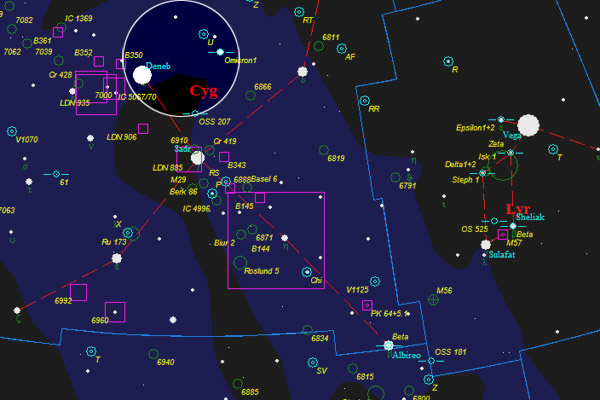
Annotated finder chart for Omnicron Cygni. Original chart from TUBA
These last nights, though brightened by the full moon, have been clear, cool, and relatively free of bugs and so as tends to be the case this time of year I find myself drawn to spending more time under the night sky.
Moonlit nights are a good time for observing double stars as the brightened sky does little to diminish their beauty. Out I went with my 60mm scope and copy of Double Stars for Small Telescopes to explore Cygnus.
With Deneb (Alpha Cygni) shining bright near the zenith I pointed my telescope roughly towards the tail of the swan and looked through the 6×30 finder. I was surprised to see what appeared to be a wide double star with a striking color contrast.
Looking at my Pocket Sky Atlas I determined I was looking in the area of Omnicron Cygni, which actually fits in the same ~7° finder field as Deneb. Omnicron Cygni has two components, Omnicron1 and Omnicron2, both of which appear reddish-orange through the finder.
O1 Cygni was the double star that first caught my attention. Its companion is 30 Cygni which shines cool blue. Taking a closer look through the finder another dim blue spark is visible closer to O1. Yes, Omnicron1 is actually a triple star.
All of this is visible through the 6×30 finder but how is the view through a 60mm telescope? First, the star colors are much more apparent. Looking at O1 at ~40x, its warm reddish color stands out, while 30 Cygni appears bluish-white, and O1‘s dimmer companion appears blue.
While this power brings out the colors nicely, the star grouping actually looks a bit nicer at lower magnifications. I really enjoy it around 14x and I’ll make a point to revisit it in my 16×50 binoculars.
Omnicron2 Cygni is worth a look as well. At low powers O2 Cygni appears as if it is part of a small, loose cluster; its shape reminded me of a kite.
I spent time looking at a few other doubles in the area, including Albireo (Beta Cygni). Albireo is considered a wide double and though barely splits in a 6-8x finder its golden amber and blue components are a beautiful sight at fairly low powers in a scope.
While Omnicron Cygni doesn’t match Albeiro for pure beauty, its visual complexity gives it a bit more depth and I’ll be returning to it often. For a great visual overview of Omnicron Cygni, see Jerry Lodriguss’s photographs of the grouping.
-Dave
Original content copyright 2015 by David Philips. All Rights Reserved. This post may contain links to affiliate sites; sales through affiliate links may benefit this site.